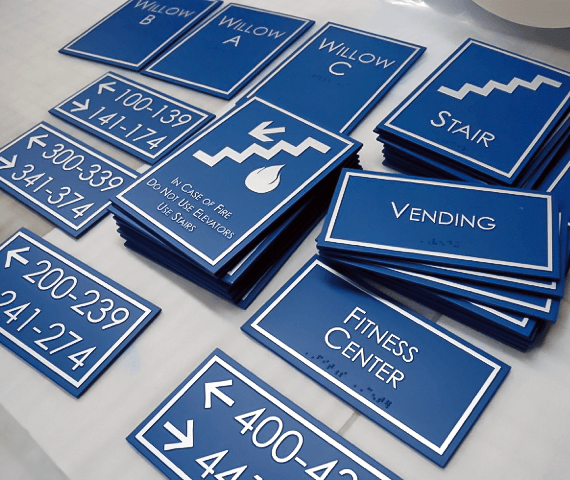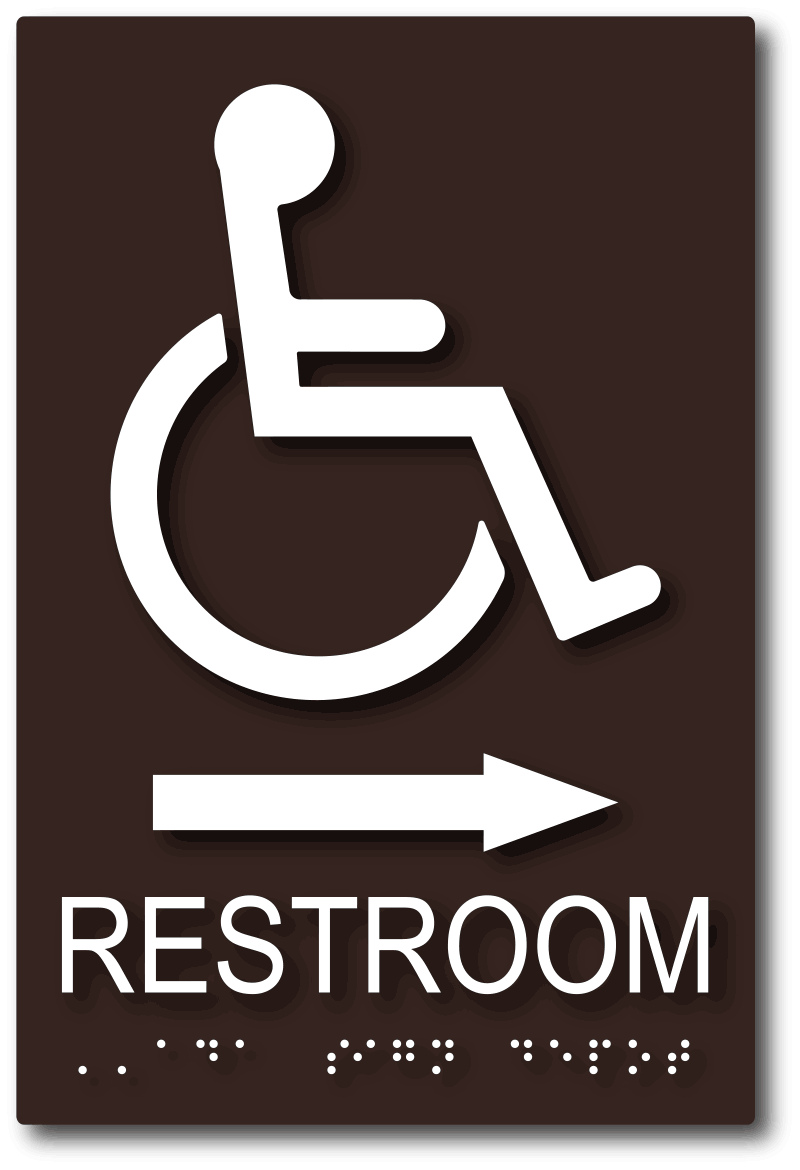The Influence of ADA Signs on Community Access
The Influence of ADA Signs on Community Access
Blog Article
Checking Out the Secret Attributes of ADA Signs for Enhanced Accessibility
In the world of access, ADA indications offer as quiet yet effective allies, making certain that spaces are accessible and comprehensive for individuals with impairments. By integrating Braille and tactile aspects, these indicators break barriers for the visually damaged, while high-contrast color systems and understandable typefaces provide to diverse visual requirements.
Significance of ADA Conformity
Guaranteeing conformity with the Americans with Disabilities Act (ADA) is crucial for promoting inclusivity and equal access in public spaces and work environments. The ADA, passed in 1990, mandates that all public facilities, companies, and transport services accommodate people with specials needs, ensuring they enjoy the same legal rights and opportunities as others. Conformity with ADA criteria not just fulfills lawful obligations however also enhances an organization's online reputation by showing its dedication to variety and inclusivity.
One of the essential aspects of ADA compliance is the execution of easily accessible signage. ADA indicators are developed to make certain that individuals with specials needs can easily navigate through rooms and structures.
Moreover, sticking to ADA laws can alleviate the risk of possible penalties and lawful repercussions. Organizations that fall short to adhere to ADA standards may encounter legal actions or fines, which can be both damaging and financially difficult to their public image. Hence, ADA compliance is important to fostering an equitable setting for everybody.
Braille and Tactile Aspects
The consolidation of Braille and tactile aspects into ADA signage personifies the principles of ease of access and inclusivity. These features are crucial for people who are blind or aesthetically damaged, enabling them to navigate public spaces with greater independence and self-confidence. Braille, a tactile writing system, is crucial in giving composed information in a layout that can be conveniently perceived with touch. It is normally placed underneath the equivalent text on signs to make sure that people can access the information without visual aid.
Responsive elements expand past Braille and consist of elevated characters and icons. These elements are designed to be noticeable by touch, allowing individuals to identify area numbers, toilets, leaves, and other vital areas. The ADA establishes particular guidelines relating to the dimension, spacing, and positioning of these responsive aspects to maximize readability and make certain consistency throughout different environments.

High-Contrast Color Pattern
High-contrast color design play a crucial function in boosting the visibility and readability of ADA signage for people with aesthetic disabilities. These systems are essential as they make best use of the difference in light reflectance in between message and history, guaranteeing that signs are easily noticeable, also from a distance. The Americans with Disabilities Act (ADA) mandates making use of certain color contrasts to fit those with restricted vision, making it a critical element of compliance.
The efficiency of high-contrast shades depends on their ability to attract attention in various illumination problems, including dimly lit settings and areas with glare. Generally, dark text on a light history or light text on a dark background is utilized to accomplish ideal contrast. As an example, black message on a yellow or white background provides a raw visual distinction that helps in quick recognition and comprehension.

Legible Fonts and Text Dimension
When taking into consideration the style of ADA signs, the choice of clear typefaces and proper message size can not be overstated. The Americans with Disabilities Act (ADA) mandates that fonts must be sans-serif and not italic, oblique, manuscript, very ornamental, or of unusual type.
The dimension of the text additionally plays a crucial role in accessibility. According to ADA standards, the minimal message height need to be 5/8 inch, and it must raise proportionally with watching range. This is particularly crucial in public rooms where signage demands to be read swiftly and properly. Consistency in message dimension adds to a natural aesthetic experience, aiding individuals in navigating settings effectively.
Additionally, spacing in between lines and letters is integral to clarity. Sufficient spacing prevents characters from showing up crowded, enhancing readability. By sticking to these standards, designers can significantly boost accessibility, guaranteeing that signs serves its desired purpose for all individuals, regardless of their aesthetic abilities.
Efficient Placement Approaches
Strategic placement of ADA signs is essential for taking full advantage of accessibility and guaranteeing compliance with legal standards. Effectively located indicators direct people with impairments efficiently, assisting in navigating in public spaces. Trick factors to consider consist of elevation, presence, and closeness. ADA standards stipulate that indicators must be mounted at an elevation between 48 to 60 inches from the ground to guarantee they are within the line of view for both standing and seated individuals. This standard height variety is critical for inclusivity, enabling wheelchair customers and people of varying heights to accessibility info effortlessly.
Additionally, signs need to be positioned beside the lock side of doors to permit easy recognition before entry. This positioning helps individuals situate areas and areas without obstruction. In situations where there is no door, indicators must be positioned on the closest surrounding wall. Uniformity in indicator placement throughout a facility improves predictability, reducing complication and enhancing general individual experience.

Conclusion
ADA indications play a vital duty in advertising access by integrating features that address the needs of individuals with impairments. Incorporating Braille and responsive elements ensures important info is accessible to the aesthetically impaired, while high-contrast shade systems and readable sans-serif font styles improve visibility across numerous illumination try this site problems. Effective placement techniques, such as appropriate mounting elevations and calculated locations, better assist in navigating. These elements collectively cultivate a comprehensive setting, underscoring the value of ADA conformity in making certain equal accessibility for all.
In the realm of availability, ADA signs offer as silent yet effective allies, ensuring that areas are accessible and comprehensive for individuals with specials needs. The ADA, passed in 1990, mandates that all public our website centers, companies, and transportation solutions accommodate people with disabilities, ensuring they appreciate the very same civil liberties and opportunities as others. ADA Signs. ADA indicators are developed to ensure that individuals with specials needs can quickly browse via buildings and spaces. ADA guidelines state that indications must be installed at an elevation in between 48 to 60 inches from the ground to ensure they are within the line of sight for both standing and seated individuals.ADA indicators play a crucial role in promoting access by incorporating features that resolve the demands of people with handicaps
Report this page